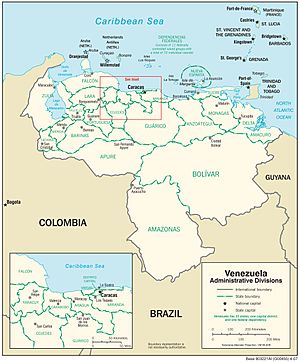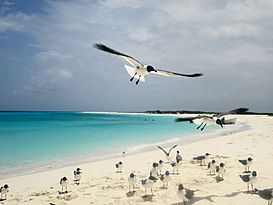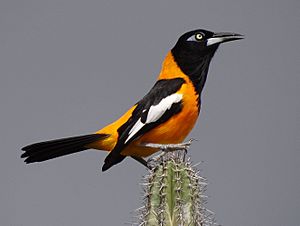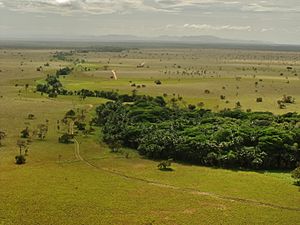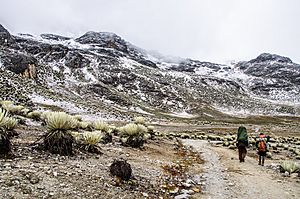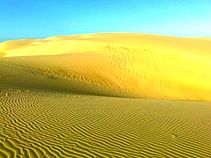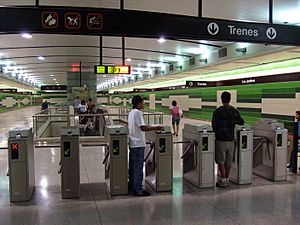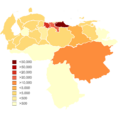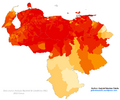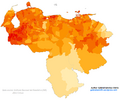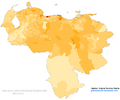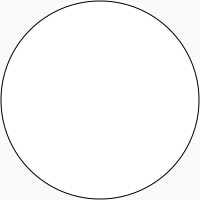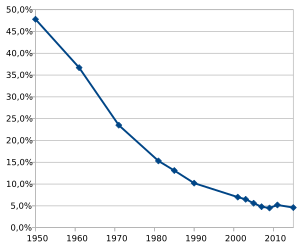Venezuela facts for kids
Quick facts for kids
Bolivarian Republic of Venezuela
República Bolivariana de Venezuela (Spanish)
|
|
|---|---|
|
Motto: Dios y Federación
("God and Federation") |
|
|
Anthem: Gloria al Bravo Pueblo (Spanish)
("Glory to the Brave People") |
|
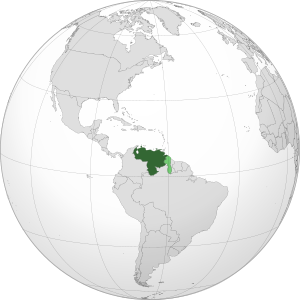 Location on the Western Hemisphere Location on the Western HemisphereLand controlled by Venezuela shown in dark green; claimed but uncontrolled land shown in light green.
|
|
| Capital and largest city
|
Caracas 10°30′N 66°55′W / 10.500°N 66.917°W |
| Official languages | Spanish |
| Recognized regional languages |
26 languages
Piapoco
Baniwa Locono Wayúu Warao Pemón Panare Yek'uana Yukpa Carib Akawaio Japrería Mapoyo Yawarana Hodï Puinave Jivi Barí Uruak Sapé Pumé Piaroa Yanomamö Sanemá Yanam Yeral |
| Ethnic groups
(2011)
|
|
| Religion
(2020)
|
|
| Demonym(s) | Venezuelan |
| Government | Federal presidential republic under a centralized authoritarian state |
| Nicolás Maduro | |
| Delcy Rodríguez | |
| Legislature | National Assembly |
| Independence from Spain | |
|
• Declared
|
5 July 1811 |
|
• from Gran Colombia
|
13 January 1830 |
|
• Recognized
|
29 March 1845 |
|
• Current constitution
|
20 December 1999 |
| Area | |
|
• Total
|
916,445 km2 (353,841 sq mi) (32nd) |
|
• Water (%)
|
3.2% |
| Population | |
|
• 2023 estimate
|
30,518,260 (50th) |
|
• Density
|
33.74/km2 (87.4/sq mi) (144st) |
| GDP (PPP) | 2022 estimate |
|
• Total
|
|
|
• Per capita
|
|
| GDP (nominal) | 2022 estimate |
|
• Total
|
|
|
• Per capita
|
|
| Gini (2013) | ▲ 44.8 medium |
| HDI (2021) | medium · 120th |
| Currency | Venezuelan bolívar (official) United States dollar (de-facto recognised, unofficial) |
| Time zone | UTC−4 (VET) |
| Date format | dd/mm/yyyy (CE) |
| Driving side | right |
| Calling code | +58 |
| ISO 3166 code | VE |
| Internet TLD | .ve |
|
|
Venezuela ( VEN-ə-ZWAY-lə;), officially the Bolivarian Republic of Venezuela (Spanish: República Bolivariana de Venezuela), is a country on the northern coast of South America. It has a territory of 916,445 km2 (353,841 sq mi), and its population was estimated at 29 million in 2022. The capital and largest urban agglomeration is the city of Caracas.
Venezuela is a charter member of the United Nations (UN), Organization of American States (OAS), Union of South American Nations (UNASUR), Bolivarian Alliance for the Peoples of Our America (ALBA), Mercosur, Latin American Integration Association (LAIA) and Organization of Ibero-American States (OEI).
Contents
Borders
The contry is bordered on the north by the Caribbean Sea and the Atlantic Ocean, on the west by Colombia, Brazil on the south, Trinidad and Tobago to the north-east and on the east by Guyana. Venezuela is a presidential republic consisting of 23 states, the Capital District and federal dependencies covering Venezuela's offshore islands.
History
The territory of Venezuela was inhabited about 15,000 years ago.
In 1498, during his third voyage to the Americas, Christopher Columbus sailed near the Orinoco Delta and landed in the Gulf of Paria. Amazed by the great offshore current of freshwater which deflected his course eastward, Columbus expressed in a letter to Isabella and Ferdinand that he must have reached Heaven on Earth (terrestrial paradise.
The territory of Venezuela was colonized by Spain in 1522. Indigenous peoples resisted. It is not known how many people lived in Venezuela before the Spanish conquest; it has been estimated at one million. After the conquest, the population dropped markedly, mainly due to new infectious diseases from Europe.
In 1811, it became one of the first Spanish-American territories to declare independence from the Spanish. It became part of the first federal Republic of Colombia (Gran Colombia). It became a fully sovereign country in 1830.
During the 19th century, Venezuela suffered political turmoil and autocracy. The counrty was ruled by regional military dictators until the mid-20th century.
Since 1958, the country has had a series of democratic governments, and the period was characterized by economic prosperity. Economic shocks in the 1980s and 1990s led to major political crises and widespread social unrest. The collapse in confidence in the existing parties saw the 1998 Venezuelan presidential election, the catalyst for the Bolivarian Revolution, which began with a 1999 Constituent Assembly, where a new Constitution of Venezuela was imposed. The government's social welfare policies were bolstered by soaring oil prices, temporarily increasing social spending, and reducing economic inequality and poverty in the early years of the regime. However, poverty began to rapidly increase in the 2010s.
The 2013 Venezuelan presidential election was widely disputed leading to widespread protest, which triggered another nationwide crisis that continues to this day.
Venezuela is a developing country. The excesses and poor policies of the government led to the collapse of Venezuela's entire economy. The country struggles with record hyperinflation, shortages of basic goods, unemployment, poverty, disease, high child mortality, malnutrition, severe crime and corruption. More than seven million refugees have fled the country.
-
Cult image sculpted in ceramic, Los Roques Archipelago.
Etymology
According to the most popular and accepted version, in 1499, an expedition led by Alonso de Ojeda visited the Venezuelan coast. The stilt houses in the area of Lake Maracaibo reminded the Italian navigator, Amerigo Vespucci, of the city of Venice, Italy, so he named the region Veneziola, or "Little Venice". The Spanish version of Veneziola is Venezuela.
Martín Fernández de Enciso, a member of the Vespucci and Ojeda crew, gave a different account. In his work Summa de geografía, he states that the crew found Indigenous people who called themselves the Veneciuela. Thus, the name "Venezuela" may have evolved from the native word.
Previously, the official name was Estado de Venezuela (1830–1856), República de Venezuela (1856–1864), Estados Unidos de Venezuela (1864–1953), and again República de Venezuela (1953–1999).
Geography
Venezuela is located in the north of South America; geologically, its mainland rests on the South American Plate. The territory is shaped like a triangle and includes numerous islands in the Caribbean and the northeast borders the northern Atlantic Ocean.
Most observers describe Venezuela in terms of four fairly well defined topographical regions: the Maracaibo lowlands in the northwest, the northern mountains extending in a broad east–west arc from the Colombian border along the northern Caribbean coast, the wide plains in central Venezuela, and the Guiana Highlands in the southeast.
The Orinoco is the largest river of the country. The Caroní and the Apure are other major rivers.
Climate
Venezuela is entirely located in the tropics over the Equator to around 12° N. Its climate varies from humid low-elevation plains, where average annual temperatures range as high as 35 °C (95.0 °F), to glaciers and highlands (the páramos) with an average yearly temperature of 8 °C (46.4 °F).
The highest temperature recorded was 42 °C (108 °F) in Machiques, and the lowest temperature recorded was −11 °C (12 °F), reported from an uninhabited high altitude at Páramo de Piedras Blancas (Mérida state).
Annual rainfall varies from 430 mm (16.9 in) in the semiarid portions of the northwest to over 1,000 mm (39.4 in) in the Orinoco Delta of the far east and the Amazonian Jungle in the south. The precipitation level is lower in the period from August through April. These periods are referred to as hot-humid and cold-dry seasons. Another characteristic of the climate is this variation throughout the country by the existence of a mountain range called "Cordillera de la Costa" which crosses the country from east to west. The majority of the population lives in these mountains.
Biodiversity and conservation
Animals of Venezuela are diverse and include manatees, three-toed sloth, two-toed sloth, Amazon river dolphins, and Orinoco Crocodiles, which have been reported to reach up to 6.6 m (22 ft) in length. Important birds include ibises, ospreys, kingfishers, and the yellow-orange Venezuelan troupial, the national bird. Notable mammals include the giant anteater, jaguar, and the capybara, the world's largest rodent. More than half of Venezuelan avian and mammalian species are found in the Amazonian forests south of the Orinoco.
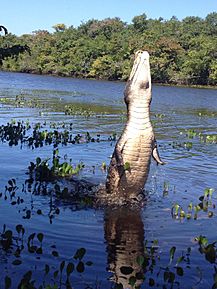
Among plants of Venezuela, over 25,000 species of orchids are found in the country.
Venezuela is among the top 20 countries in terms of endemism. Among its animals, 23% of reptilian and 50% of amphibian species, including the Trinidad poison frog, are endemic. Although the available information is still very small, a first effort has been made to estimate the number of fungal species endemic to Venezuela: 1334 species of fungi have been tentatively identified as possibly endemic. Some 38% of the over 21,000 plant species known from Venezuela are unique to the country.
Venezuela is one of the 10 most biodiverse countries on the planet, yet it is one of the leaders of deforestation due to economic and political factors. Each year, roughly 287,600 hectares of forest are permanently destroyed and other areas are degraded by mining, oil extraction, and logging. Between 1990 and 2005, Venezuela officially lost 8.3% of its forest cover, which is about 4.3 million ha. In response, federal protections for critical habitat were implemented.
In 2003, 70% of the nation's land was under conservation management in over 200 protected areas, including 43 national parks. Venezuela's 43 national parks include Canaima National Park, Morrocoy National Park, and Mochima National Park. In the far south is a reserve for the country's Yanomami tribes. Covering 32,000 square miles (82,880 square kilometres), the area is off-limits to farmers, miners, and all non-Yanomami settlers.
Venezuela was one of the few countries that did not enter an INDC at COP21. Many terrestrial ecosystems are considered endangered, specially the dry forest in the northern regions of the country and the coral reefs in the Caribbean coast.
There are 105 protected areas in Venezuela, which cover around 26% of the country's continental, marine and insular surface.
Hydrography
The country is made up of three river basins: the Caribbean Sea, the Atlantic Ocean and Lake Valencia.
On the Atlantic side it drains most of Venezuela's river waters. The largest basin in this area is the extensive Orinoco basin whose surface area, close to one million km2, is greater than that of the whole of Venezuela, although it has a presence of 65% in the country.
The size of this basin - similar to that of the Danube - makes it the third largest in South America, and it gives rise to a flow of some 33,000 m³/s, making the Orinoco the third largest in the world, and also one of the most valuable from the point of view of renewable natural resources. The Rio or Brazo Casiquiare is unique in the world, as it is a natural derivation of the Orinoco that, after some 500 km in length, connects it to the Negro River, which in turn is a tributary of the Amazon.
Relief
The Venezuelan natural landscape is the product of the interaction of tectonic plates that since the Paleozoic have contributed to its current appearance. On the formed structures, seven physical-natural units have been modeled, differentiated in their relief and in their natural resources.
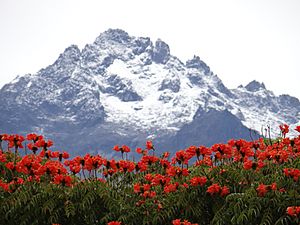
The relief of Venezuela has the following characteristics: coastline with several peninsulas and islands, adenas of the Andes mountain range (north and northwest), Lake Maracaibo (between the chains, on the coast); Orinoco river delta, region of peneplains and plateaus (tepui, east of the Orinoco) that together form the Guyanas massif (plateaus, southeast of the country).
The oldest rock formations in South America are found in the complex basement of the Guyanas highlands and in the crystalline line of the Maritime and Cordillera massifs in Venezuela. The Venezuelan part of the Guyanas Altiplano consists of a large granite block of gneiss and other crystalline Archean rocks, with underlying layers of sandstone and shale clay.
The core of granite and cordillera is, to a large extent, flanked by sedimentary layers from the Cretaceous, folded in an anticline structure. Between these orographic systems there are plains covered with tertiary and quaternary layers of gravel, sands and clayey marls. The depression contains lagoons and lakes, among which is that of Maracaibo, and presents, on the surface, alluvial deposits from the Quaternary.
Also known as the Cordillera de la Costa, stretches along Venezuela's northern coast. This region is known for its lush tropical rainforests, stunning coastal views, and a rich variety of flora and fauna. The intermountain depressions, or valleys, between the mountain ranges are often home to fertile agricultural land and vibrant communities. These valleys offer a stark contrast to the rugged mountains that rise dramatically from the coast.
- Lara-Falcón Highlands
Situated in northwestern Venezuela, the Lara-Falcón Highlands exhibit a terrain defined by plateaus and rolling hills. These highlands provide a significant contrast to the surrounding lowlands and coastal areas. The relief is characterized by gently sloping plateaus that support agriculture, including coffee and cacao cultivation. This region's semi-arid climate and picturesque landscapes make it an important agricultural and tourism center.
Encompass the basin of Lake Maracaibo and the plains surrounding the Gulf of Venezuela. This region offers two distinct plains—the northern one is relatively dry, while the southern one is humid and dotted with swamps. The relief here is primarily characterized by flat terrain, with the exception of some elevated areas near the lake. Lake Maracaibo itself sits in a depression, surrounded by oil-rich lands and productive agricultural areas.
The Venezuelan Andes, part of the broader Andes mountain range, offer a striking relief with towering peaks, deep valleys, and fertile intermontane basins. Dominated by these corpulent mountain ranges, including Venezuela's highest peak, Bolívar Peak, the region's rugged and picturesque landscapes are defined by its high-altitude terrain. The unique relief of this area finds its origins in the Last Glacial Period, where the interplay of repeated glacier advances and retreats sculpted the landscape, shaped by the cold, high-altitude climate. This glacial heritage has left a lasting imprint, with glaciers carving deep valleys and polishing rugged peaks, while sheltered intramontane valleys offer fertile soils and temperate microclimates, creating ideal conditions for agriculture and human settlement.
- Los Llanos
Los Llanos, or "the plains", are expansive sedimentary basins characterized by predominantly flat relief. However, the eastern Llanos feature low-plateaus and the Unare depression, created through mesa erosion, adding diversity to the terrain. This region is subject to seasonal flooding, transforming the flat plains into a vast wetland during the rainy season. The relief here influences the region's unique ecosystems, including extensive grasslands and abundant wildlife.
- Guiana Shield
The Guiana Shield boasts a varied relief shaped by geological processes over millions of years. This region encompasses peneplains, rugged mountain ranges, foothills, and the iconic tepuis, or table-top mountains. The tepuis stand as isolated, flat-topped plateaus that rise dramatically from the surrounding terrain. This unique relief contributes to the region's remarkable biodiversity and scientific significance.
The Orinoco Delta's relief is characterized by a complex system of lands and waters. It consists of numerous channels, islands, and shifting sedimentary deposits. While the relief may appear relatively uniform, it conceals a dynamic environment influenced by seasonal flooding and sediment deposition. This complex deltaic relief supports diverse aquatic life and the livelihoods of Indigenous communities adapted to its ever-changing landscapes.
Valleys
The valleys are undoubtedly the most important type of landscape in the Venezuelan territory, not because of their spatial extension, but because they are the environment where most of the country's population and economic activities are concentrated. On the other hand, there are valleys throughout almost all the national space, except in the great sedimentary basins of the Llanos and the depression of the Maracaibo Lake, except also in the Amazonian peneplains. By their modeling, the valleys of the Venezuelan territory belong mainly to two types: valleys of fluvial type and valleys of glacial type. Much more frequent, the former largely dominate the latter, which are restricted to the highest parts of the Andes. Moreover, most glacial valleys are relics of a past geologic epoch, which culminated some 10,000 to 12,000 years ago.
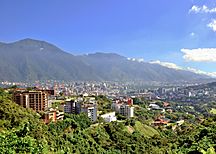
The deep and narrow Andean valleys are very different from the wide depressions of Aragua and Carabobo, in the Cordillera de la Costa, or from the valleys nestled in the Mesas de Monagas. These examples indicate that the configuration of the local relief is decisive in identifying regional types of valleys. Likewise, due to their warm climate, the Guayana valleys are distinguished from the temperate or cold Andean valleys by their humid environment. Both are, in turn, different from the semi-arid depressions of the states of Lara and Falcón.
The Andean valleys, essentially agricultural, precociously populated but nowadays in loss of speed, do not confront the same problems of space occupation as the strongly urbanized and industrialized valleys of the central section of the Cordillera de la Costa. On the other hand, the unpopulated and practically untouched Guiana valleys are another category this area is called the Lost World (Mundo Perdido).
The Andean valleys are undoubtedly the most impressive of the Venezuelan territory because of the energy of the encasing reliefs, whose summits often dominate the valley bottoms by 3,000 to 3,500 meters of relative altitude. They are also the most picturesque in terms of their style of habitat, forms of land use, handicraft production and all the traditions linked to these activities.
Deserts
Venezuela has a great diversity of landscapes and climates, including arid and dry areas. The main desert in the country is in the state of Falcon near the city of Coro. It is now a protected park, the Médanos de Coro National Park. The park is the largest of its kind in Venezuela, covering 91 square kilometres. The landscape is dotted with cacti and other xerophytic plants that can survive in humidity-free conditions near the desert.
Desert wildlife includes mostly lizards, iguanas and other reptiles. Although less frequent, the desert is home to some foxes, giant anteaters and rabbits. There are also some native bird populations, such as the sparrowhawk, tropical mockingbird, scaly dove and crested quail.
Other desert areas in the country include part of the Guajira Desert in the Guajira Municipality in the north of Zulia State and facing the Gulf of Venezuela, the Médanos de Capanaparo in the Santos Luzardo National Park in Apure State, the Medanos de la Isla de Zapara in Zulia State, the so-called Hundición de Yay in the Andrés Eloy Blanco Municipality of Lara State, and the Urumaco Formation also in Falcón State.
-
Victoria Lagoon, Mérida State
-
Valencia Lake, formerly praised by Alexander von Humboldt for its beauty, is massively polluted due to the countless sewage systems pouring residuals.
Government and politics
The Venezuelan president is elected by a vote, with direct and universal suffrage, and is both head of state and head of government. The term of office is six years, and (as of 15 February 2009) a president may be re-elected an unlimited number of times. The president appoints the vice president and decides the size and composition of the cabinet and makes appointments to it with the involvement of the legislature. The president can ask the legislature to reconsider portions of laws he finds objectionable, but a simple parliamentary majority can override these objections.
The president may ask the National Assembly to pass an enabling act granting the ability to rule by decree in specified policy areas; this requires a two-thirds majority in the Assembly. Since 1959, six Venezuelan presidents have been granted such powers.
The unicameral Venezuelan parliament is the Asamblea Nacional ("National Assembly"). The number of members is variable – each state and the Capital district elect three representatives plus the result of dividing the state population by 1.1% of the total population of the country. Three seats are reserved for representatives of Venezuela's Indigenous peoples. For the 2011–2016 period the number of seats is 165. All deputies serve five-year terms.
The voting age in Venezuela is 18. Voting is not compulsory.
The legal system of Venezuela belongs to the Continental Law tradition. The highest judicial body is the Supreme Tribunal of Justice or Tribunal Supremo de Justicia, whose magistrates are elected by parliament for a single two-year term. The National Electoral Council (Consejo Nacional Electoral, or CNE) is in charge of electoral processes; it is formed by five main directors elected by the National Assembly. Supreme Court president Luisa Estela Morales said in December 2009 that Venezuela had moved away from "a rigid division of powers" toward a system characterized by "intense coordination" between the branches of government. Morales clarified that each power must be independent.
Military
The Bolivarian National Armed Forces of the Bolivarian Republic of Venezuela (Fuerza Armada Nacional Bolivariana, FANB) are the overall unified military forces of Venezuela. It includes over 320,150 men and women, under Article 328 of the Constitution, in 5 components of Ground, Sea and Air. The components of the Bolivarian National Armed Forces are: the Venezuelan Army, the Venezuelan Navy, the Venezuelan Air Force, the Venezuelan National Guard, and the Venezuelan National Militia.
The main roles of the armed forces are to defend the sovereign national territory of Venezuela, airspace, and islands, to search and rescue and, in the case of a natural disaster, civil protection. All male citizens of Venezuela have a constitutional duty to register for the military service at 18, which is the age of majority.
-
National Assembly of Venezuela building
-
La Casona presidential residence in Caracas, now a museum.
-
A Sukhoi Su-30MKV of the Venezuelan Air Force
Administrative divisions
Venezuela is divided into 23 states (estados), a capital district (distrito capital) corresponding to the city of Caracas, and the Federal Dependencies (Dependencias Federales, a special territory). Venezuela is further subdivided into 335 municipalities (municipios); these are subdivided into over one thousand parishes (parroquias). The states are grouped into nine administrative regions (regiones administrativas), which were established in 1969 by presidential decree.
The country can be further divided into ten geographical areas, some corresponding to climatic and biogeographical regions. In the north are the Venezuelan Andes and the Coro region, a mountainous tract in the northwest, holds several sierras and valleys. East of it are lowlands abutting Lake Maracaibo and the Gulf of Venezuela.
The Central Range runs parallel to the coast and includes the hills surrounding Caracas; the Eastern Range, separated from the Central Range by the Gulf of Cariaco, covers all of Sucre and northern Monagas. The Insular Region includes all of Venezuela's island possessions: Nueva Esparta and the various Federal Dependencies. The Orinoco Delta, which forms a triangle covering Delta Amacuro, projects northeast into the Atlantic Ocean.
The country maintains a historical claim on the territory it calls Guyana Esequiba, the territory administered by Guyana west of the Esequibo River. In 1966 the British and Venezuelan governments signed the Geneva Agreement to resolve the conflict peacefully. The Port of Spain Protocol of 1970 set a deadline to try to resolve the issue, without success to date.
Largest cities
|
Largest cities or towns in Venezuela
|
||
|---|---|---|
| Rank | Name | Pop. |
| 1 | Caracas | 2,904,376 |
| 2 | Maracaibo | 1,906,205 |
| 3 | Valencia | 1,396,322 |
| 4 | Barquisimeto | 996,230 |
| 5 | Ciudad Guayana | 706,736 |
| 6 | Maturín | 542,259 |
| 7 | Barcelona | 421,424 |
| 8 | Maracay | 407,109 |
| 9 | Cumaná | 358,919 |
| 10 | Barinas | 353.851 |
Tourism
Margarita Island is one of the top tourist destinations. It is an island with a modern infrastructure, bordered by beaches suitable for extreme sports, and features castles, fortresses and churches of great cultural value.
Los Roques Archipelago is made up of a set of islands and keys that constitute one of the main tourist attractions in the country. With exotic crystalline beaches, Morrocoy is a national park, formed by small keys very close to the mainland, which have grown rapidly as one of the greatest tourist attractions in the Venezuelan Caribbean.
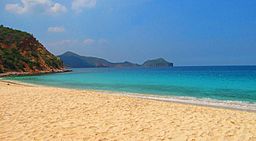
Canaima National Park extends over 30,000 km2 to the border with Guyana and Brazil; due to its size it is considered the sixth largest national park in the world. Its steep cliffs and waterfalls (including Angel Falls, which is the highest waterfall in the world, at 1,002 m) form spectacular landscapes.
The state of Mérida is one of the main tourist centers of Venezuela. It has an extensive network of hotels not only in its capital city, but also throughout the state. Starting from the same city of Mérida is the longest and highest cable car in the world, which reaches the Pico Espejo of 4,765 m.
World Heritage sites
There are three World Heritage Sites in the country:
| Site | Image | Location (state) | Year listed | UNESCO data | Description |
|---|---|---|---|---|---|
| Coro and its Port | 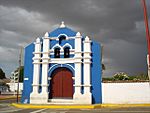 |
Falcón | 1993 | 658; iv, v (cultural) | Founded in 1527 by the Spanish as one of the first colonial settlements in the region, the city of Coro and its port, La Vela, have preserved their urban layout and numerous historical buildings. The buildings are made in the bahareque technique (using an interwoven bamboo sticks or reeds, covered by mud), adobe, and rammed earth. Architecturally, the older buildings are in Spanish and Mudéjar styles while from the second half of the 17th century, they were influenced by the Dutch style. In 2005, the site has been listed as endangered because of the damage caused by heavy rains in the previous year and because of new constructions that threaten the integrity of the property. |
| Canaima National Park | 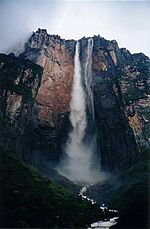 |
Bolívar | 1994 | 701; vii, viii, ix, x (natural) | The outstanding features of the national park are the tepui, table-top mountains or mesas that have been created through hundreds of millions of years of erosion. Due to isolation, the summits of the tepui are inhabited by numerous endemic animal and plant species. Among many waterfalls in the park, Angel Falls (pictured) is the world's tallest uninterrupted waterfall with a vertical fall of around 1,000 m (3,300 ft). |
| Ciudad Universitaria de Caracas | 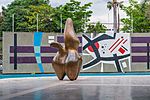 |
Capital District | 2000 | 986; i, iv (cultural) | The University City was built between 1940 and 1960, following the designs of the architect Carlos Raúl Villanueva. The complex includes numerous structures and art installations, including a stadium, the Aula Magna with the sculpture of Floating Clouds, and a botanical garden. It represents an outstanding example of modern architecture, in this case adjusted for the tropical climate of the region. The Berger des Nuages sculpture is pictured. |
Landmarks of Caracas
- Paseo Los Próceres
- Palacio Municipal de Caracas
- National Pantheon
- El Ávila National Park
- Caracas Cathedral
Transport
Venezuela is connected to the world primarily via air (Venezuela's airports include the Simón Bolívar International Airport in Maiquetía, near Caracas and La Chinita International Airport near Maracaibo) and sea (with major sea ports at La Guaira, Maracaibo and Puerto Cabello). In the south and east the Amazon rainforest region has limited cross-border transport; in the west, there is a mountainous border of over 2,213 kilometres (1,375 mi) shared with Colombia. The Orinoco River connects the major industrial city of Ciudad Guayana to the Atlantic Ocean.
Venezuela has a limited national railway system, which has no active rail connections to other countries. The government of Hugo Chávez tried to invest in expanding it, but Venezuela's rail project is on hold due to Venezuela not being able to pay the $7.5 billion and owing China Railway nearly $500 million.
Several major cities have metro systems; the Caracas Metro has been operating since 1983. The Maracaibo Metro and Valencia Metro were opened more recently.
Venezuela has a road network of nearly 100,000 kilometres (62,000 mi), placing the country around 45th in the world; around a third of roads are paved.
Ethnicity
The people of Venezuela come from a variety of ancestries. It is estimated that the majority of the population is of pardo, or mixed, ethnic ancestry.
According to an autosomal DNA study conducted in 2008 by the University of Brasília, the composition of Venezuela's population is 60.60% European, 23% Indigenous, and 16.30% African.
-
Amerindian population of Venezuela in 2011.
Languages
Although most residents are Spanish speakers, many other languages are spoken in Venezuela. In addition to Spanish, the Constitution recognizes more than thirty Indigenous languages, including Wayuu, Warao, Pemón, and many others for the official use of the Indigenous peoples, mostly with few speakers – less than 1% of the total population. Wayuu is the most spoken Indigenous language, with 170,000 speakers.
Immigrants, in addition to Spanish, speak their own languages. Chinese (400,000), Portuguese (254,000), and Italian (200,000) are the most-spoken languages in Venezuela after the official language of Spanish. Arabic is spoken by Lebanese and Syrian colonies on Isla de Margarita, Maracaibo, Punto Fijo, Puerto la Cruz, El Tigre, Maracay, and Caracas. Portuguese is spoken not only by the Portuguese community in Santa Elena de Uairén but also by much of the population due to its proximity to Brazil. The German community speaks their native language, while the people of Colonia Tovar speak mostly an Alemannic dialect of German called alemán coloniero.
English is the most widely used foreign language in demand and is spoken by many professionals, academics, and members of the upper and middle classes as a result of the oil exploration by foreign companies, in addition to its acceptance as a lingua franca. Culturally, English is common in southern towns like El Callao, and the native English-speaking influence is evident in folk and calypso songs from the region. English was brought to Venezuela by Trinidadian and other British West Indies immigrants. A variety of Antillean Creole is spoken by a small community in El Callao and Paria. Italian language teaching is delivered by private Venezuelan schools and institutions. Other languages spoken by large communities in the country are Basque and Galician, among others.
Religion
Religion in Venezuela (2011) Catholic (71%) Protestant (17%) No religion (7%) Other religion (3%) No answer (1%)
According to a 2011 poll, 88% of the population is Christian, primarily Roman Catholic (71%), and the remaining 17% Protestant, primarily Evangelicals (in Latin America Protestants are usually called "evangélicos"). 8% of Venezuelans are irreligious. Almost 3% of the population follow another religion (1% of these people practice Santería).
There are small but influential Muslim, Druze, Buddhist, and Jewish communities. The Muslim community of more than 100,000 is concentrated among persons of Lebanese and Syrian descent living in Nueva Esparta state, Punto Fijo and the Caracas area. Venezuela is home of the largest Druze communities outside the Middle East, the Druze community are estimated around 60,000, and concentrated among persons of Lebanese and Syrian descent. Buddhism is practiced by over 52,000 people. The Buddhist community is made up mainly of Chinese, Japanese, and Korean people.
The Jewish community has shrunk in recent years due to rising economic pressures and antisemitism in Venezuela, with the population declining from 22,000 in 1999 to less than 7,000 in 2015.
Education
In 2008, 95.2% of the adult population was literate. Venezuela has a number of universities, of which the most prestigious are the Central University of Venezuela founded in 1721, the University of Zulia, the University of the Andes, Simón Bolívar University, and the University of the East.
Currently, many Venezuelan graduates seek a future abroad. Over 1.35 million Venezuelan college graduates have left the country since the beginning of the Bolivarian Revolution. It is believed that nearly 12% of Venezuelans live abroad, with Ireland becoming a popular destination for students. According to Claudio Bifano, president of the Venezuelan Academy of Physical, Mathematical, and Natural Sciences, more than half of all medical graduates had left Venezuela in 2013.
By 2018, over half of all Venezuelan children had dropped out of school, with 58% of students quitting nationwide while areas near bordering countries saw more than 80% of their students leave. Nationwide, about 93% of schools do not meet the minimum requirements to operate and 77% do not have utilities such as food, water or electricity.
Culture
The culture of Venezuela is a melting pot made up of three main groups: The Indigenous Venezuelans, the Africans, and the Spanish.
The Africans brought in many musical influences, especially introduction of the drum. The Spanish influence predominantes due to the colonization process and the socioeconomic structure it created. Spanish influences can be seen in the country's architecture, music, religion, and language.
Venezuela was also enriched by immigration streams of Indian and European origin in the 19th century, especially from France. Most recently, immigration from the United States, Spain, Italy, and Portugal has enriched the already complex cultural mosaic.
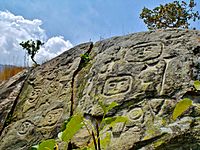
Architecture
Carlos Raúl Villanueva was the most important Venezuelan architect of the modern era; he designed the Central University of Venezuela, (a World Heritage Site) and its Aula Magna. Other notable architectural works include the Capitolio, the Baralt Theatre, the Teresa Carreño Cultural Complex, and the General Rafael Urdaneta Bridge.
In Venezuela, prehistoric man began to build useful architecture from approximately 1000 B.C. to the 15th century A.D., in the period known as the "Neo-Indian". Neo-Indian architecture consisted of such constructions as agricultural terraces and vaults lined by stones, called mintoyes, which were used as tombs and silos for the storage of agricultural products. Venezuelan colonial architecture is built from the 16th century, when Venezuela began to be a dependent colony of the Spanish Empire, until 1810, when the process of Venezuelan independence began.
-
The historic center of Coro, a UNESCO World Heritage Site, is an example of Spanish colonial architecture in Venezuela.
-
Basilica of Our Lady of Chiquinquirá, built between 1686 and completed in 1858, where is kept the colonial image of the Virgin of Chiquinquirá, in Maracaibo.
-
St. Martin of Tours Catholic Church in Colonia Tovar, a German-style town built in 1840s-1850s by German immigrants in Venezuela.
Art
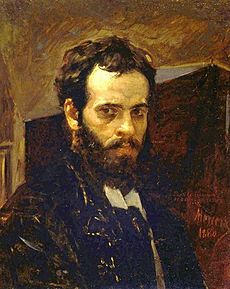
Venezuelan art was initially dominated by religious motifs. However, in the late 19th century, artists began emphasizing historical and heroic representations of the country's struggle for independence. This move was led by Martín Tovar y Tovar. Modernism took over in the 20th century. Notable Venezuelan artists include Arturo Michelena, Cristóbal Rojas, Armando Reverón, Manuel Cabré; the kinetic artists Jesús Soto, Gego and Carlos Cruz-Diez; and contemporary artists such as Marisol and Yucef Merhi.
Literature
Venezuelan literature originated soon after the Spanish conquest of the mostly pre-literate Indigenous societies. It was originally dominated by Spanish influences. Following the rise of political literature during the Venezuelan War of Independence, Venezuelan Romanticism, notably expounded by Juan Vicente González, emerged as the first important genre in the region. Although mainly focused on narrative writing, Venezuelan literature was advanced by poets such as Andrés Eloy Blanco and Fermín Toro.
Major writers and novelists include Rómulo Gallegos, Teresa de la Parra, Arturo Uslar Pietri, Adriano González León, Miguel Otero Silva, and Mariano Picón Salas. The great poet and humanist Andrés Bello was also an educator and intellectual (He was also a childhood tutor and mentor of Simón Bolívar). Others, such as Laureano Vallenilla Lanz and José Gil Fortoul, contributed to Venezuelan Positivism.
Music
The Indigenous musical styles of Venezuela are exemplified by groups like Un Solo Pueblo and Serenata Guayanesa. The national musical instrument is the cuatro.
The Zulian gaita is also a very popular genre, generally performed during Christmas. The national dance is the joropo.
Venezuela has always been a melting pot of cultures and this can be seen in the richness and variety of its musical styles and dances: calipso, bambuco, fulía, cantos de pilado de maíz, cantos de lavanderas, sebucán, and maremare. Teresa Carreño was a world-famous 19th century piano virtuoso. Recently, great classical music performances have come out of Venezuela. The Simón Bolívar Youth Orchestra has hosted a number of excellent concerts in many European concert halls, most notably at the 2007 London Proms, and has received several honors. The orchestra is the pinnacle of El Sistema, a publicly financed, voluntary music education program now being emulated in other countries.
In the early 21st century, a movement known as "Movida Acústica Urbana" featured musicians trying to save some national traditions, creating their own original songs but using traditional instruments. Some groups following this movement are Tambor Urbano, Los Sinverguenzas, C4Trío, and Orozco Jam.
-
The Guanaguanare dance, a popular dance in Portuguesa State.
Sport
The origins of baseball in Venezuela are unclear, although it is known that the sport was being played in the country by the late 19th century. In the early 20th century, North American immigrants who came to Venezuela to work in the nation's oil industry helped to popularize the sport in Venezuela. During the 1930s, baseball's popularity continued to rise in the country, leading to the foundation of the Venezuelan Professional Baseball League (LVBP) in 1945, and the sport would soon become the nation's most popular.
The popularity of baseball in the country makes Venezuela a rarity among its South American neighbors—association football is the dominant sport in the continent. However, football, as well as basketball, are among the more popular sports played in Venezuela. Venezuela hosted the 2012 Basketball World Olympic Qualifying Tournament and the 2013 FIBA Basketball Americas Championship, which took place in the Poliedro de Caracas.
Although not as popular in Venezuela as the rest of South America, football, spearheaded by the Venezuela national football team is gaining popularity as well. The sport is also noted for having an increased focus during the World Cup. Venezuela is scheduled to host the Copa América every 40 years.
Venezuela is also home to former Formula 1 driver, Pastor Maldonado. Maldonado has increased the reception of Formula 1 in Venezuela, helping to popularize the sport in the country.
In the 2012 Summer Olympics, Rubén Limardo won a gold medal in fencing.
In the Winter Sports, Cesar Baena had represented the country since 2008 in Nordic Skiing, the first South American skier to compete in a FIS Cross Country Ski World Cup on Düsseldorf 2009.
-
Venezuela national football team, popularly known as the "Vinotinto"
Cuisine
Interesting facts about Venezuela
- Venezuela is the 33rd largest country in the world.
- Venezuela is among the most urbanized countries in Latin America; the vast majority of Venezuelans live in the cities of the north and in the capital.
- Venezuela ranks low in international measurements of freedom of the press and civil liberties and has high levels of corruption.
- The counrty has the world's largest known oil reserves and has been one of the world's leading exporters of oil.
- Venezuela hosts a total of 1,417 bird species, 48 of which are endemic. The yellow-orange Venezuelan troupial is the national bird.
- Venezuela has a national universal health care system.
See also
 In Spanish: Venezuela para niños
In Spanish: Venezuela para niños




